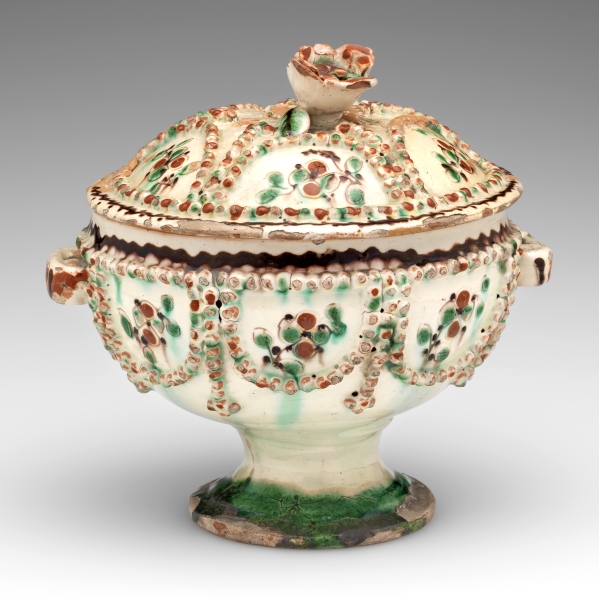
Box with beaded decoration, Heimberg 1816 (Musée Ariana, Geneva, MAG R 178).
Langnau beaded decoration in CERAMICA CH
Langnau Variant 2, Perldekor in CERAMICA CH
Heimberg-Steffisburg beaded decoration in CERAMICA CH
Andreas Heege, 2019
Beaded decoration was one of the characteristic elements of “Heimberg type” pottery. The origin, date and development of this type of pottery remain unclear. This is partly due to the fact that, so far, no vessels with beaded decoration have come to light in any of the archaeological assemblages from the 19th century in the Canton of Bern. The decoration is also notably absent from the pottery in the production waste from Steffisburg, Höchhus (Baeriswyl 2008) and Langnau, Sonnweg 1 (Heege/Kistler 2017/2, 154–183).
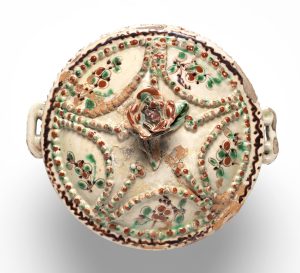

Box with beaded decoration, Heimberg 1816 (Musée Ariana, Geneva, MAG R 178).
Against this background, this box from 1816 (MAG R 178) stands out. Not only does it bear a date, but also the name of the potter, Friedrich Gfeller, and perhaps its place of origin “ÿm Heimberg”. The only other object firmly associated with this potter dates from 1829. At that time he resided in Opplingen “beir Rotachen Brügg”, i.e. very near Heimberg. That was where one Hans Gfeller had a potter’s workshop between 1827 and 1829 (StAB Bez Konolfingen B 1434). The association of beaded decoration with the region of Heimberg-Steffisburg resulting from this is also consistent with the insight gained by Karl Huber, the city archivist of Thun. In a piece on the history of the production of Heimberg pottery for the “Illustriertes Fremdenblatt Thun und Umgebung” in 1906, Huber wrote: “In the early 19th century, Heimberg was reinvigorated. A new, unusual type of decoration was introduced: small balls of clay were attached to the vessel surfaces in rows, arches or other formations. The predominant colours added to the greenish-white slip were emerald-green, brick-red, a deep yellow and sometimes brown […]” (Huber 1906, 278).

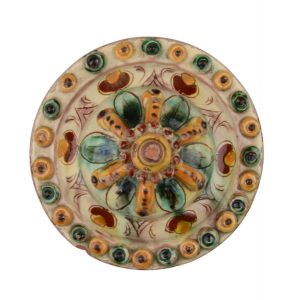
Box from Langnau Bern, Workshop 3, Hand 5, 1783 (Regionalmuseum Langnau RML A-426).
However, this statement appears to be only one part – though an important one – of the genesis of beaded decoration. Again, we must look towards Langnau. The earliest examples of beads of clay being used for decorative purposes were a volute handle on the lid of a Langnau box from 1783 (RML A-426), an unusual footed box from 1798 (MAG AR 2016-352) and a volute handle on the lid of a typical Langnau tureen from 1799 (MAHN AA-1178). Roughly at the same time, i.e. in the years 1800 to 1801, the footrings on Langnau “wedding tureens” (SMB IV-12; MAHN AA-3317) and stylistically related tureens (cf. MAG R 232) were being finished off by adding beaded decoration. Boxes from this period also bore beading on the neck of the bowl or on the rim of the lid (MAG AR 908b). Crown knobs on the lids of tureens from between 1802 (RML A163) and 1822 (SNM LM-009739) also sometimes bore beaded decoration on the edges (MAHN AA 1180; MAHN AA 1182, MAHN AA 1304).
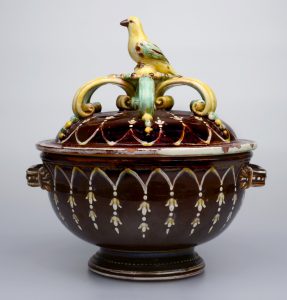

Tureen Switzerland, Canton of Bern, Langnau, Workshop 3, c. 1803 (Musée Ariana, Geneva MAG AR 927).
The same decoration can also be found on usually red and more rarely white slipped lids of tureens and sugar boxes with volute handles (cf. MAG AR 927, MAG AR 921), though not in very prominent positions but rather on the edges. Contrary to Heimberg wares, it did not form garlands or spread onto the surface of these vessels, which were typical of Langnau production based on their shapes and decorations. The most recent example firmly associated with a Langnau workshop dates from 1834 (Bischofberger Gallery, Männedorf, 9077, Heege/Kistler 2017/2, Fig. 483,2). Could this mean that the evolution of beaded decoration on Heimberg vessels was inspired by Langnau examples?
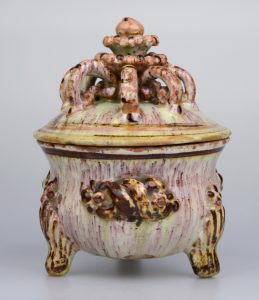

Box from Switzerland, Canton of Bern, Langnau or Heimberg-Steffisburg region, Workshop Langnau variant 2, c. 1800-1830 (Musée Ariana, Geneva MAG 07304).
Another phenomenon worth mentioning in this context is the use of beaded decoration on vessels of the Langnau varaiant 2 group (e.g. MAG 07304). Based on dated pieces, we know that they were made between 1809 and 1818 and were even brought to Pennsylvania, USA by an unknown emigrant potter (perhaps Johannes Lehmann?).
Many “Heimberg type” vessels with white slip both inside and out and decorated with beading can be found in museums, with shapes ranging from boxes to tureens, money boxes, vases, milk jugs and coffee pots. They probably all date from the first two thirds of the 19th century (MAG R 178, MAG 16698, MAG AR 2015-364, MAG N 850, MAG AR 2015-366, MAG N 196).
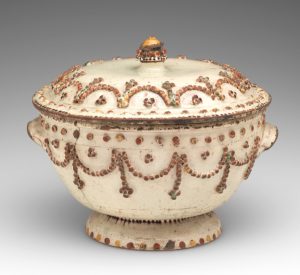
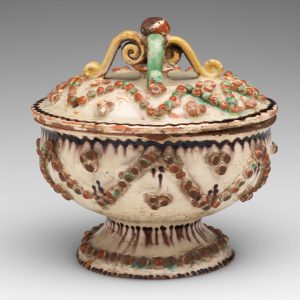
A tureen with a high pedestal foot (footring), Switzerland, Canton of Bern, Heimberg-Steffisburg (region), “Heimberg type” pottery, circa 1830-1860 (Musée Ariana, Geneva MAG 16698) and a box with a pedestal foot, Switzerland, Canton of Bern, Heimberg-Steffisburg (region), c. 1830-1860 (Museé Ariana, Geneva MAG AR 2015-364).
The box MAG R 178 bears the date 1816 and is one of only two dated pieces with this type of decoration. The second, a money box with beaded decoration in the Regional Museum of Langnau, bears the date 1859 (RML A306).
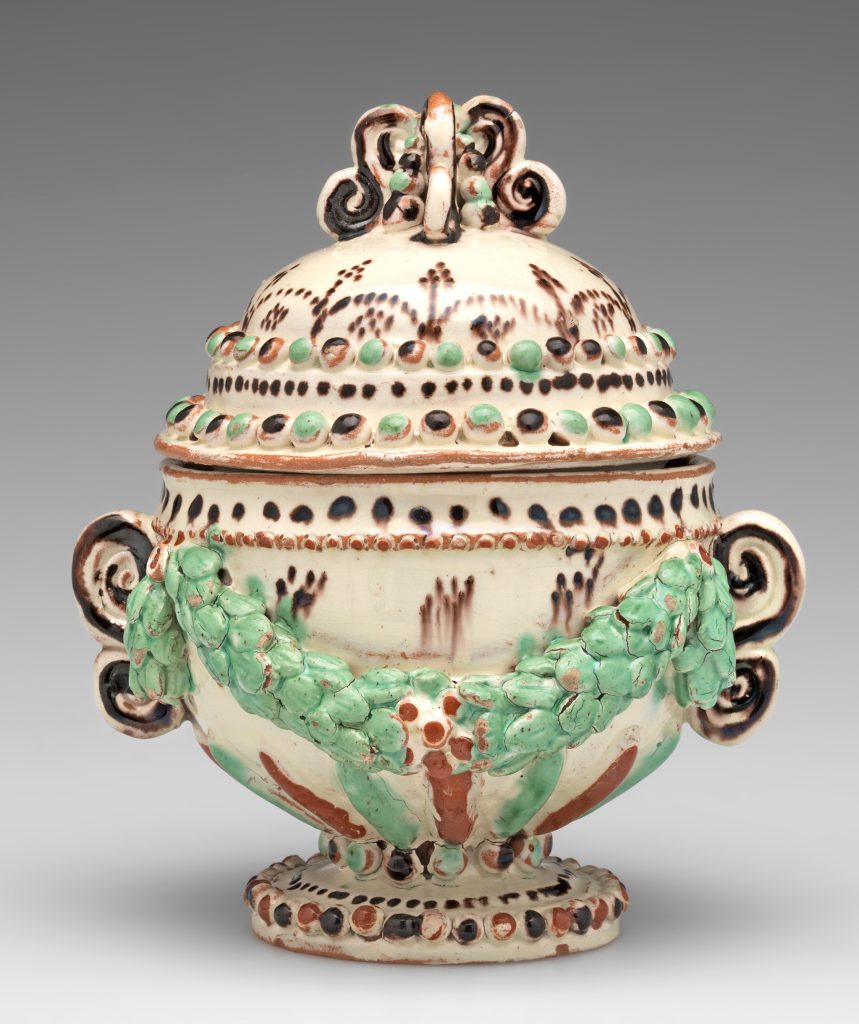
Box with a low pedestal foot, Switzerland, Canton of Bern, Heimberg-Steffisburg (region), c. 1840-1860 (Musée Ariana, Geneva MAG N 196).
The addition of a laurel garland and rouletted beading beneath the rim could perhaps point to a somewhat later date for MAG N 196, though this assumption cannot be supported by dated pieces.
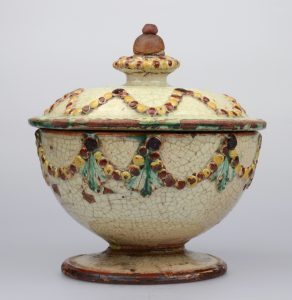

Box, Langnau Bern, Workshop 5, Hand 21, c. 1830-1840 (Musée d’art et d’histoire, Neuchâtel, MAHN AA-1186) and box, Langnau Bern, Workshop 5, Hand 20, c. 1830 (Musée d’art et d’histoire, Neuchâtel MAHN AA-1196).
Another group of boxes with white slip on both sides and beaded garlands with the addition of various applied decorations date from the 1830s and 1840s (see e.g. MAHN AA 1196, MAHN AA 1202, MAHN AA 1451). Moulds and patrices for creating the applied decorations have survived in Langnau (privately owned). They were used at the “Im Gräbli” workshop (Langnau Workshop 5, Hand 20; Langnau Workshop 5, Hand 21; Heege/Kistler 2017/2, 378–381) and also serve as evidence for the local production of vessels with beaded garlands in Langnau. One box from this group bears the date 1831 (SNM LM-009255). Could it be that these boxes from the “Im Gräbli” workshop in Langnau show that this popular decorative technique from the Heimberg region was adopted by Langnau potters in the 1830s?
It must be noted that none of the Langnau boxes with beaded decoration bear any incised or trailed flower and leaf designs or rows of black-brown dots that could be compared to those on MAG R 178. Both motifs, however, are quite often found on pieces with beaded garlands in the Musée Ariana in Geneva (see MAG 16698, MAG AR 2015-364, MAG AR 2015-366, MAG N 196). Other popular motifs include dark-brown dotted diamonds or triangles as well as slender floral panicles (see MAHN AA 1254).
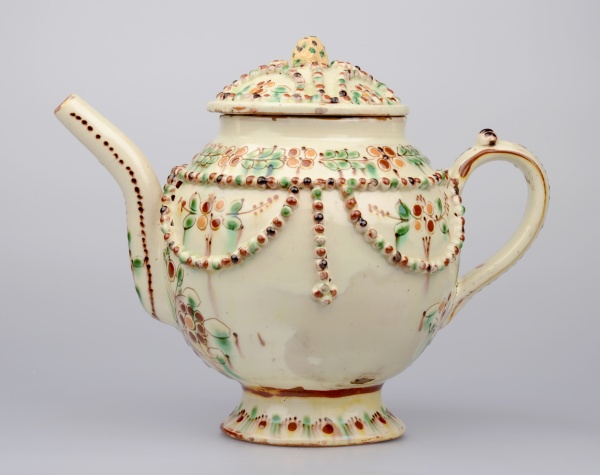
Teapot with beaded garlands, Switzerland, Canton of Bern, Heimberg-Steffisburg (region), c. 1830-1850 (Musée d’art et d’histoire, Neuchâtel MAHN AA 1254.
These motifs most definitely originated in Heimberg. From 1806 onwards, slender floral panicles were ever-present on “Heimberg type” pottery with dark or red slip coating (earliest example: BHM 6485). Between 1827 (MKW 229) and 1863 (SMT 4896) the motif was also used on “Heimberg type” pottery with white slip coating. Incised and then painted petals and leaves on a coating of white slip first occurred on a shaving basin in the Regional Museum of Langnau bearing the date 1813 (RML A78) and subsequently appeared regularly on “Heimberg type” pottery.
However, since many of the lids on the white boxes and tureens with beaded garlands also bore reduced or advanced versions of volute handles, which were typical of Langnau ware (MAG AR 2015-364, MAG N 850, MAG N 196), we might ask what exactly was happening in the first two thirds of the 19th century and who copied what from whom. In other words, are we looking at Heimberg products with earlier decorations and handle types from Langnau or are they Langnau wares with decorative motifs from Heimberg? Pottery with beaded decoration is an obvious manifestation of the close ties between the two areas and also heralds the end of the Langnau style and the increasing predominance of Heimberg-style decorations even on products from Langnau.
In the absence of new archaeological finds from the areas concerned, the question of where these wares were actually made will continue to be difficult to answer. The boxes and tureens in the collection of the Musée Ariana in Geneva (MAG R 178; MAG 16698, MAG AR 2015-364, MAG N 850, MAG AR 2015-366, MAG N196) were probably made in Heimberg. Conclusive evidence for the production of such vessels with beaded decoration and incised flower/leaf motifs in Langnau has not yet been found.
Translation Sandy Haemmerle
German: Perldekor
French: décor de perles
References:
Heege/Kistler 2017/1
Andreas Heege/Andreas Kistler, Poteries décorées de Suisse alémanique, 17e-19e siècles – Collections du Musée Ariana, Genève – Keramik der Deutschschweiz, 17.-19. Jahrhundert – Die Sammlung des Musée Ariana, Genf, Mailand 2017, 457-469.
Heege/Kistler 2017/2
Andreas Heege/Andreas Kistler, Keramik aus Langnau. Zur Geschichte der bedeutendsten Landhafnerei im Kanton Bern (Schriften des Bernischen Historischen Museums 13), Bern 2017.
Huber 1906
Karl Huber, Thuner Majolika, in: Illustriertes Fremdenblatt von Thun und Umgebung, 1906, 258-259, 278-279, 294-296.

